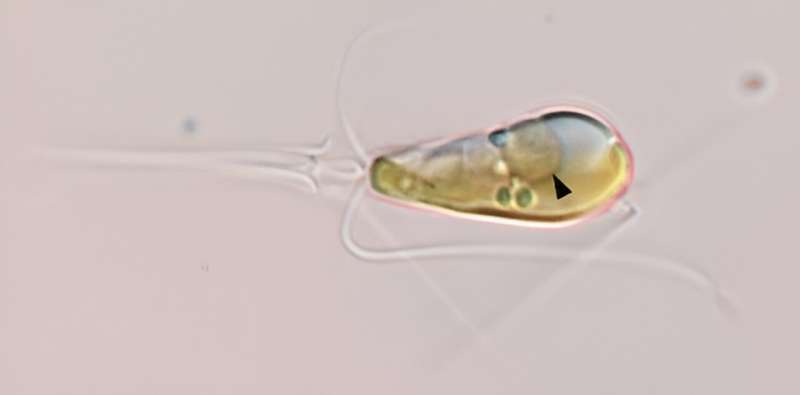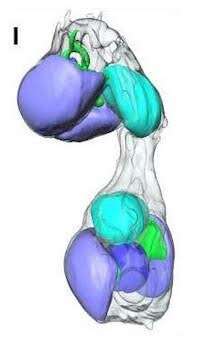
A light microscope image shows the marine haptophytic alga Braarudosphaera bigelowii with a black arrow pointing to the nitroplast organelle. Credit: Tyler Cole
Modern biology textbooks claim that only bacteria can take nitrogen from the atmosphere and convert it into a form usable by life. Plants that fix nitrogen, such as legumes, do so by harboring symbiotic bacteria in root nodules. But a recent discovery turns that rule on its head.
In two recent papers, an international team of scientists describes the first known nitrogen-fixing organelle in a eukaryotic cell. The organelle is the fourth example in history of primary endosymbiosis—the process by which a prokaryotic cell is engulfed by a eukaryotic cell and develops beyond symbiosis into an organelle.
“It’s very rare for organelles to arise from these kinds of things,” said Tyler Cole, a postdoctoral fellow at UC Santa Cruz and first author of one of two recent papers. “The first time we think it happened gave rise to all the complex life. Everything more complex than a bacterial cell owes its existence to this event,” he said, referring to the origin of mitochondria. “About a billion years ago, this happened again to the chloroplast, and that gave us plants,” Cole said.
The third known case involved a chloroplast-like microbe. The latest discovery is the first example of a nitrogen-fixing organelle, which the researchers call a nitroplast.
A decade-old mystery
Discovering the organelle involved a bit of luck and decades of work. In 1998, Jonathan Zehr, a distinguished professor of marine science at the University of California, Santa Cruz, discovered a short DNA sequence of what appeared to be an unknown nitrogen-fixing cyanobacterium in Pacific seawater. Zehr and his colleagues spent years studying the mysterious organism, which they named UCYN-A.
At the same time, Kyoko Hagino, a paleontologist at Kochi University in Japan, was diligently trying to cultivate seaweed. It turned out to be a host organism for UCYN-A. It took her over 300 sampling expeditions and more than a decade, but Hagino eventually successfully grew the alga in culture, allowing other researchers to begin studying UCYN-A and its seaweed host together in the lab.
For years, scientists considered UCYN-A to be an endosymbiont that is closely related to an alga. But the two recent papers suggest that UCYN-A co-evolved with its host in the past symbiosis and now meets the criteria for an organelle.
Origin of organelles
In an article published in cell in March 2024, Zehr and colleagues at MIT, Institut de Ciències del Mar in Barcelona, and the University of Rhode Island showed that the size ratio between UCYN-A and their algal hosts is similar in different species of the marine haptophytic algae Braarudosphaera bigelowii.
The researchers used a model to demonstrate that host cell growth and UCYN-A are controlled by nutrient exchange. Their metabolism is related. This synchronization in growth rates led the researchers to call UCYN-A “organelle-like.”
“That’s exactly what happens with organelles,” Zehr said. “If you look at the mitochondria and the chloroplast, it’s the same thing: they scale with the cell.”

Soft X-ray tomography image shows cell division of B. bigelowii with nitroplasts (UCYN-A) in cyan. Credit: Valentina Loconte
But the scientists didn’t confidently call UCYN-A an organelle until they confirmed other lines of evidence. In the article on the cover of the magazine Sciencepublished today, Zehr, Coale, Kendra Turk-Kubo, and Wing Kwan Esther Mak of UC Santa Cruz and collaborators from UC San Francisco, Lawrence Berkeley National Laboratory, National Taiwan Ocean University, and Kochi University in Japan show that UCYN- A imports proteins from its host cells.
“That’s one of the hallmarks of something moving from an endosymbiont to an organelle,” Zehr said. “They start shedding bits of DNA, and their genomes get smaller and smaller, and they start depending on the mother cell for those gene products — or the protein itself — to be transported into the cell.”
Cole worked on proteomics for the study. He compared the proteins found in isolated UCYN-A with those found in the whole algal host cell. He discovered that the host cell produces proteins and tags them with a specific amino acid sequence that tells the cell to send them to the nitroplast. The nitroplast then imports the proteins and uses them. Coale identified the function of some of the proteins and they fill gaps in certain pathways within UCYN-A.
“It’s kind of like this magic puzzle that actually fits and works,” Zehr said.
In the same paper, UCSF researchers show that UCYN-A replicates in sync with the algal cell and is inherited like other organelles.
Changing perspectives
These independent lines of evidence leave little doubt that UCYN-A has surpassed the role of a symbiont. And while mitochondria and chloroplasts evolved billions of years ago, the nitroplast appears to have evolved about 100 million years ago, giving scientists a new, more recent perspective on organelleogenesis.
The organelle also provides insight into ocean ecosystems. All organisms require nitrogen in a biologically usable form, and UCYN-A is globally important for its ability to fix nitrogen from the atmosphere. Researchers have found it everywhere from the tropics to the Arctic Ocean, and it fixes a significant amount of nitrogen.
“It’s not just another player,” Zehr said.
The discovery also has the potential to change agriculture. The ability to synthesize ammonia fertilizers from atmospheric nitrogen allowed agriculture—and the world’s population—to take off in the early 20th century. Known as the Haber-Bosch process, it makes about 50% of the world’s food production possible. It also creates huge amounts of carbon dioxide: about 1.4% of global emissions come from the process. For decades, researchers have been trying to find a way to incorporate natural nitrogen fixation into agriculture.
“This system is a new perspective on nitrogen fixation and may provide clues as to how such an organelle can be engineered into crop plants,” Cole said.
But many questions about UCYN-A and its algal host remain unanswered. The researchers plan to delve deeper into how UCYN-A and the algae work and study different strains.
Kendra Turk-Cubo, an assistant professor at UC Santa Cruz, will continue the research in her new lab. Zehr expects scientists to find other organisms with evolutionary histories similar to UCYN-A, but as the first of its kind, this discovery is one for the textbooks.
More info:
Tyler H. Coale et al, Nitrogen-fixing organelles in seaweeds, Science (2024). DOI: 10.1126/science.adk1075
Francisco M. Cornejo-Castillo et al, Metabolic trade-offs limit cell size ratio in a nitrogen-fixing symbiosis, cell (2024). DOI: 10.1016/j.cell.2024.02.016
Provided by University of California – Santa Cruz
Quote: Scientists discover first nitrogen-fixing organelle (2024, April 11) Retrieved April 12, 2024, from https://phys.org/news/2024-04-scientists-nitrogen-organelle-1.html
This document is subject to copyright. Except for any fair dealing for the purposes of private study or research, no part may be reproduced without written permission. The content is provided for informational purposes only.

